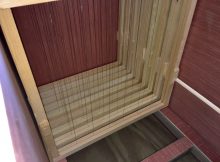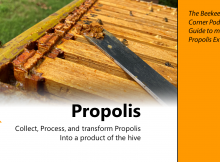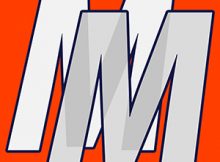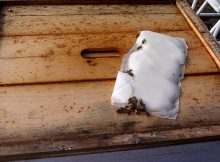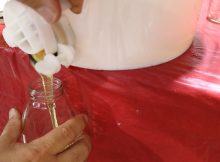This past weekend I had a few moments so I started poking around looking at different hive form factors. I spoke of some that I previewed in Episode 106 and wanted to expand on a facet of hive design that has my interest right now.
Disclaimer: I know this is not a new idea and I am not trying to pass it off as a new idea. This is how I think out loud and document my methods of where I am at any given time. I am adding this disclaimer as sometimes well meaning folks can’t help but share with me that so and so had this idea before and it is not original. In this post I am simply taking some time to work it out for myself and as customary I am taking you along for the ride if you care to follow.
Take a look at this frame design of this hive… it is a photo from the hive I shot a video of this past weekend and it is perfect to illustrate the point I want to explore
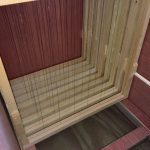
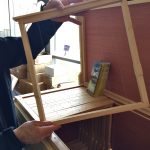
9 1/8th Inch Because of Weight
It is not a new concept but there is an underlying concept with the design in the photo. If a bee had a cavity to build a comb for use would they constrain it to the size of what we provide in a Langstroth box? No probably not. It is not designed for the bee, it is designed for us.
Consider that a Langstroth frame dimension for foundation is around 9 inches (40 centimeters) and it is that height is that dimension because if made any bigger the box that contains it, and the other 9 frames, would be too heavy. Its shape and dimension are a matter of practicality in a system that was built to be movable.
Would the Bees Prefer a deeper Frame?
If we could all be superman and weight was no object, would we have designed something differently; I think we would. Practicality would take on a new meaning and the height of a frame would would not be constrained by the weight incurred by way of its dimension. It might not be evident but using a deep box dimension is a compromise between weight and providing the largest comb surface for the bees to operate. As an aside, there’s a knock on all medium hive setups – meaning using all medium hive boxes instead of combinations of deeps and mediums – as they might lessen the box weight but there’s a bar every 6 inches and that interrupts the continuity of the face of the comb for the bees. So to the question, would the bees prefer a deeper frame? Let’s hold off on tackling that question for a second.
Smaller Nests and Frequent Swarming
An article from J Loftus, Michael Smith, and Tom Seeley has been out about a year now that implies that smaller hives and the willingness to let them swarm results in healthier colonies. Bob Kloss and I talk about his little top bar hive that he has and we’ve pondered, even out loud on the podcast, why that hive seems to thrive and survive. It has a touch of the recipe that I am exploring here with the notion of collapsing two deep brood boxes into one continuous box that is a bit smaller in dimension. (Link to the Smaller Nest Research Article)
So what if we considered…
What if we built this hive for the hobbyist, and didn’t intend to be moving it on pallets? What if a hive was a single box for the brood chamber? What if we employed deeper frames with large expanses for comb? What if it was insulated or used substrate that was as thick as a tree? I’ll go even further of what if it were suspended and secured high up in a tree? What if it employed a pulley system so we could lower it to the ground to work on it. What if it were allowed to swarm?
If one could shape wood, and if one could lift any weight they wanted…
Let’s brainstorm a design?
Objective: Compromise between making something exotic and using off the shelf components and standards if they work in the design – but the bees come first.
What should we change about the hive dimensions and components?
- Maybe we tweak the hive cavity dimension. Keep the Langstroth Length and Width dimension* (19 7/8″ X 16 1/4) but make it deeper so the entire brood chamber fit in one box.
* The thought here is we would still keep open an option to put standard Langstroth Honey Supers on top if we so desired. - Design frames that hive sides but no bottom bar to take advantage of the bottom hive shape (see next bullet)
- Make the bottom “brood” box curved on the bottom in a natural way (Golden Ratio/Catenary Curve) so bees will not be enticed to attach the comb
- This could be done in some other creative way. Perhaps a board on a slant instead of a literal curved bottom for example.
- Employ skewers, wires or different techniques to give the comb more rigidity but since it is the brood chamber and we’re not going to be moving comb to extract a simple reinforcement should suffice.
- One could use foundation sheets like starter strips for the top half and take advantage of foundation wiring to get started.
- Kelley “F” Style Frames with openings to allow bees to pass through. To operate it like a top bar; closed to bees passing through the frame bars to the space above by placing a burlap cloth over the top bars. If you want to allow passage, take off the burlap.
- The entrance can be what we think it should be. I like the idea of the KEWL floor entrance that I’ve talked about in the past. It provides an alternate entrance that negates darting robber bees. Of course the entrance can simply be a hole in the side of the hive box like a hole in a tree. We can make it whatever we want it to be. (http://theapiarist.org/kewl-floor)
What do we end up with?
It is a hive box with standard Langstroth X by X length and width dimensions, its contiguous depth is akin to the height of a medium sitting on top of a deep box for the brood chamber, and has a closed curved bottom. Objective met: One contiguous brood chamber. The hive box is made with substrates that are thicker in dimension, say 1 1/2 or 2″ lumber, and therefore more insulated.
What would be the possible benefits of this design?
- This design would provide more contiguous comb face for the bees.
- It would have a natural bottom to the comb – in the shape that the bees want it and as deep as the bees want it.
- It would be the right size to host a proper sized cluster to overwinter.
- It will be one box and 10 frames which is simpler than two boxes and twenty frames.
- Still can be inspected and treated if need be; Employs movable comb so it would be legal.
- Same X by X form factor as Langstroth and you could put honey supers on top for honey or expansion when swarming pressures are present
- The brood chamber would be thicker substrate and be more conducive for temperatures.
What would be the downside of the design?
- It can’t be purchased in any store.
- Frame bars could be used but sides would have to be made by the beekeeper
- The curved bottom has to be engineered in some way
- It would require a dedicated hive stand
- We are not superman, so the frames are going to be heavy
- Possibilities are there for ‘wonky’ comb
- Hard to move if needed
- Difficult to consider moving conventional Nucs frames into this hive.
- Inability to use the long frames in a honey extractor
- Note: It is not the intention to do any honey harvesting out of these frames as they are for the brood chamber so it not a very big con
Why might the bees like this?
- Larger, non interrupted, comb to work with
- Single chamber to cluster in for winter
- Closer in design, cavity wise, to a tree?
- Possible that they would store their winter stores within reach of the cluster and have better access to it then in a conventional hive
- Bees are going to be in a hive that better insulation around the brood chamber. Less work for the bees and possibly an earlier start to the year.
- Cluster not divided in the middle.
- An entrance that is suitable for the bees, the way they may see it in nature.
Conclusion
I built a top bar hive and have it in service this year – hopefully it will continue along to spring, fingers crossed. I will given another go at getting my Warre hive up and running this season and there are two homemade hives i’m interested in giving a go if time allows; This modified Langstroth and something like the Hex hive that was covered in episode 106 (https://youtu.be/L1lHXvbcBpo). I suppose one question about that hive is what’st the difference to what was proposed here. It’s pretty similar but more complex due to the ‘hex’ nature of it. Given the thickness of the substrate would the extra space created by the hex design add enough value to warrant the complexity? All good questions.
We’ll see where the summer of 2017 takes us. This actually would be a better winter project but maybe early spring will provide some opportunities to get into the workshop.







